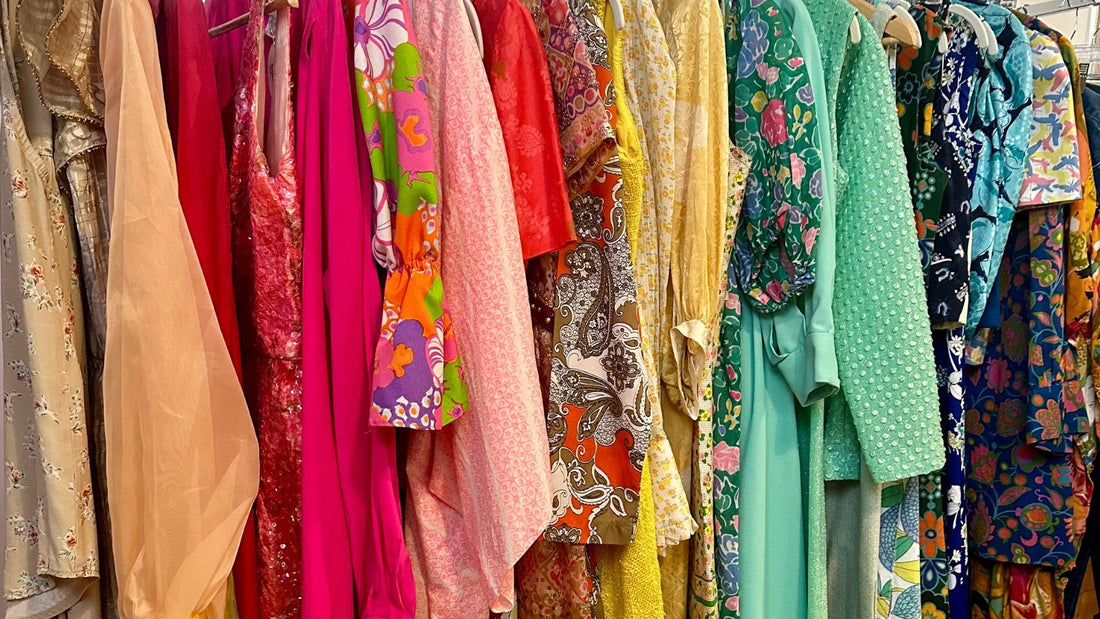So you want to get better at thrifting? First of all, congratulations. You are doing your part to lessen your carbon footprint.
Buying and wearing secondhand clothing instead of new reduces carbon emissions by an average of 25%. - ThredUp
I'm a self-proclaimed thrifting expert, but I've been buying secondhand for over 20 years. I now do so as part of my full-time career owning Blue Suede Vintage. What was once carefree browsing for quirky family reunion shirts in my middle and high school days has now turned in to a methodical, often hour-long plus, focused excursion. Even if you're on more of the "fun t-shirts" end of that spectrum, here's a rundown of how I typically approach a thrift store to help you be more mindful on your next trip.
No Carts
Carts are the curse. If you grab a cart once you enter the thrift, that likely means the Thrift Gods will send you nothing to fill it. If you bypass the carts, you'll conversely end up with painful armloads of clothing that you're schlepping around the store. It's basically a thrift prophecy at this point.
In the same vein, I never go in thinking, "I really want to find X today." That means I will find W, Y, and Z, but not X. I usually keep a running wish list but begin each thrift trip with an open mind.
Go Often
This is the tip lots of people don't want to hear. One of the most common questions I get is, "how do you thrift such great stuff?" The answer is that I go all the time. I admittedly don't source for my vintage business from the thrift store as much as I used to, but at one point I was going several times per week. I'd also rotate where I went to get the greatest reach. If you really want to catch the "grails" as the kids say, you have to go very regularly.
Shop By Sight
Ok, yes, this one seems obvious, but hear me out. Many thrift stores (at least the bigger chain ones) group items by prints and then solids by color. For example, all the printed tanks are often together, then the solid tanks are together by color. Small town thrifts are more "throw up a bunch of sh*t on a rack," but hunting on the roads less traveled requires a whole other set of tips. I digress.
When I'm shopping somewhere that's actually organized, I go for the prints first. A fun, vintage print is going to give me more of a "wow" factor than a solid color. I scan the prints quickly and over the years have learned to pick out the vintage ones versus ones that might be modern reproductions. That doesn't mean I don't get fooled. I've gotten really excited about something bright and psychedelic just to pull it out to see a Shein tag. Middle fingers allll the way up for Shein.
When you're using your eyes, you're obviously looking at tags, too, especially if you're exclusively on the hunt for vintage. That topic actually requires a whole seprate blog post. Seriously. More to come on tags.
Then Shop By Feel
Next, I shop solids and denim by feel.
First, I'm not getting the "wow" factor from prints that I might with solid basics, so I'm really going for fabrics. Some of this you can tell by sight, but much more is revealed with touch (insert inappropriate joke here). Within solid shirts I'm feeling for silks, pants I'm feeling for linen, jackets/sweaters I'm feeling for wool, etc. Your fingertips can definitely betray you here, too; some well-made polyester can almost pass for silk and great acrylics for wool, but at least this gives you a starting point.
Even if you're not strictly looking for natural fabrics like silk, linen, or wool, when you're shopping for solid, more basic items you're probably going to want synthetics that are well-done instead of cheaply made (duh). Feeling the fabrics--their weight and quality--helps immensely here.
When it comes to denim, I almost exclusively go by feel first. Vintage denim is almost always 100% cotton. Modern denim almost always isn't. Vintage denim is much heavier, and if it's worn just right, is super soft. Cheap, fast fashion denim is usually thin and stretchy. It can contain cotton but usually also contains a million other things like spandex or polyester. You can absolutely feel the difference, and this method helps me get through the denim racks quickly.
Oh yeah, after all that touching of other people's stuff your hands are probably going to feel gross when you leave. I've found that hand sanitizer just moves the dirt around. Antibacterial wipes (although not great for the planet... sigh) are the move here. Keep them in your car.
Inspect, Inspect, Inspect
If your thrifting strategy is that you're willing to put in some work to make your less-than-perfect items work for you, then go ahead and skip this section. If you're not an overachiever, read on...
I'm finding that thrift stores are steadily raising their prices, so taking gambles on items that aren't ready-to-wear is paying off less and less. Sure, sewing on a button is easy, but you've got to find the RIGHT button, then actually set aside the time to make the repair. Be honest with yourself about what you're willing to take on before ever walking through the doors of the thrift. Then buy accordingly.
I inspect everything very closely before I check out. Usually, I add everything I like to my cart, then I take time at the end of my shopping trip to do my checks: buttons, zippers, arm pits, hems. I have been burnt many times by getting overly excited about a thrift find, rushing to check out and get it home, then realizing later that is has a gross crotch stain (true story, and I'm looking at you BAM). Save yourself. Take the time BEFORE you pay to run through everything you have in your cart.
Go When the Masses Don't
I never thrift on the weekends. I don't really thrift during major school holidays like Spring Break, either, because I know I'll be competing with shrewd, young eyes for some of the same things. Less competition, more treasure! Not everyone has the luxury of thrifting whenever they want, but even when I worked a full time corporate job I'd thrift once or twice a week on my lunch break. I may or may not have stuck to my allotted hour; don't tell my boss. This leads me to my final point.
Pay Attention to Sale Days
If you're thrifting to save as much money as possible, then pay attention to sale days but know the shop will be BUSY. Some shops have select days each month when the whole store is discounted. Others use a colored tag system where certain colors are discounted at certain times. Get to know these systems at your local shops.
HOWEVER, I personally avoid sale days when the entire store is 50% off. Why? Well, first of all, I don't really feel like throwing 'bows for a $3 shirt. But really, it's because I'm thrifting for selection a little more than strictly price. I'm willing to pay a little more for the good stuff (and we're talking $8 versus $4 here). I go the day or two AFTER the big sale. The sales SHOULD clear out lots of inventory. Lower inventory means... ding ding ding: restocks! Thrift stores are typically in a constant state of restock; they're not usually just putting out new merchandise on certain days (but do ask your local thrift associates about this). Going in the days after a big sale is one of the few times they may be restocking at a faster rate than normal.
Thrifting is more competitive than ever, and unfortunately, it's getting harder and harder to find great gems or great deals. Hopefully, following the methods of someone who has been doing this in some capacity for most of her life will help you score some unique, high-quality, affordable finds for your closet (but umm, don't buy all the good stuff before I get there).
Send me a message if there's anything else you'd be interested in reading about.
Shop Blue Suede Vintage online 24/7.
Shop the retail location Saturdays & Sundays 12-5pm if you're in the Memphis area. Or we're open Mon-Fri by appointment.
 Casey O'Rourke, owner of Blue Suede Vintage, has been sourcing and collecting vintage clothing for over 20 years. She started selling her collection online through Instagram in early 2018, and Blue Suede Vintage (or, "BSV") grew from there. The retail location of BSV opened in the historic Crosstown neighborhood of Memphis, TN in 2022 and is filled with Casey's favorites from the 1920's to the early 2000's.
Casey O'Rourke, owner of Blue Suede Vintage, has been sourcing and collecting vintage clothing for over 20 years. She started selling her collection online through Instagram in early 2018, and Blue Suede Vintage (or, "BSV") grew from there. The retail location of BSV opened in the historic Crosstown neighborhood of Memphis, TN in 2022 and is filled with Casey's favorites from the 1920's to the early 2000's.


